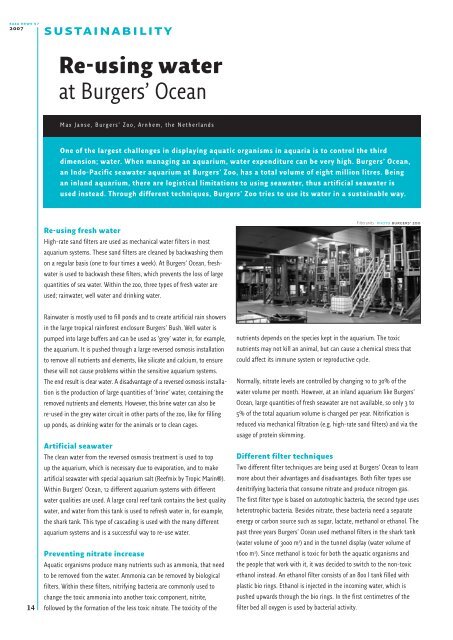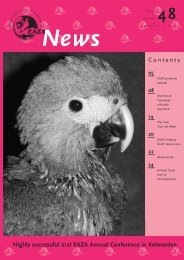EAZA News 57-12 - European Association of Zoos and Aquaria
EAZA News 57-12 - European Association of Zoos and Aquaria
EAZA News 57-12 - European Association of Zoos and Aquaria
You also want an ePaper? Increase the reach of your titles
YUMPU automatically turns print PDFs into web optimized ePapers that Google loves.
eaza news <strong>57</strong><br />
2007<br />
14<br />
sustainability<br />
Re-using water<br />
at Burgers’ Ocean<br />
Max Janse, Burgers’ Zoo, Arnhem, the Netherl<strong>and</strong>s<br />
One <strong>of</strong> the largest challenges in displaying aquatic organisms in aquaria is to control the third<br />
dimension; water. When managing an aquarium, water expenditure can be very high. Burgers’ Ocean,<br />
an Indo-Pacific seawater aquarium at Burgers’ Zoo, has a total volume <strong>of</strong> eight million litres. Being<br />
an inl<strong>and</strong> aquarium, there are logistical limitations to using seawater, thus artificial seawater is<br />
used instead. Through different techniques, Burgers’ Zoo tries to use its water in a sustainable way.<br />
Re-using fresh water<br />
High-rate s<strong>and</strong> filters are used as mechanical water filters in most<br />
aquarium systems. These s<strong>and</strong> filters are cleaned by backwashing them<br />
on a regular basis (one to four times a week). At Burgers’ Ocean, freshwater<br />
is used to backwash these filters, which prevents the loss <strong>of</strong> large<br />
quantities <strong>of</strong> sea water. Within the zoo, three types <strong>of</strong> fresh water are<br />
used; rainwater, well water <strong>and</strong> drinking water.<br />
Rainwater is mostly used to fill ponds <strong>and</strong> to create artificial rain showers<br />
in the large tropical rainforest enclosure Burgers’ Bush. Well water is<br />
pumped into large buffers <strong>and</strong> can be used as ‘grey’ water in, for example,<br />
the aquarium. It is pushed through a large reversed osmosis installation<br />
to remove all nutrients <strong>and</strong> elements, like silicate <strong>and</strong> calcium, to ensure<br />
these will not cause problems within the sensitive aquarium systems.<br />
The end result is clear water. A disadvantage <strong>of</strong> a reversed osmosis installation<br />
is the production <strong>of</strong> large quantities <strong>of</strong> ‘brine’ water, containing the<br />
removed nutrients <strong>and</strong> elements. However, this brine water can also be<br />
re-used in the grey water circuit in other parts <strong>of</strong> the zoo, like for filling<br />
up ponds, as drinking water for the animals or to clean cages.<br />
Artificial seawater<br />
The clean water from the reversed osmosis treatment is used to top<br />
up the aquarium, which is necessary due to evaporation, <strong>and</strong> to make<br />
artificial seawater with special aquarium salt (Reefmix by Tropic Marin®).<br />
Within Burgers’ Ocean, <strong>12</strong> different aquarium systems with different<br />
water qualities are used. A large coral reef tank contains the best quality<br />
water, <strong>and</strong> water from this tank is used to refresh water in, for example,<br />
the shark tank. This type <strong>of</strong> cascading is used with the many different<br />
aquarium systems <strong>and</strong> is a successful way to re-use water.<br />
Preventing nitrate increase<br />
Aquatic organisms produce many nutrients such as ammonia, that need<br />
to be removed from the water. Ammonia can be removed by biological<br />
filters. Within these filters, nitrifying bacteria are commonly used to<br />
change the toxic ammonia into another toxic component, nitrite,<br />
followed by the formation <strong>of</strong> the less toxic nitrate. The toxicity <strong>of</strong> the<br />
Filterunits photo burgers’ zoo<br />
nutrients depends on the species kept in the aquarium. The toxic<br />
nutrients may not kill an animal, but can cause a chemical stress that<br />
could affect its immune system or reproductive cycle.<br />
Normally, nitrate levels are controlled by changing 10 to 30% <strong>of</strong> the<br />
water volume per month. However, at an inl<strong>and</strong> aquarium like Burgers’<br />
Ocean, large quantities <strong>of</strong> fresh seawater are not available, so only 3 to<br />
5% <strong>of</strong> the total aquarium volume is changed per year. Nitrification is<br />
reduced via mechanical filtration (e.g. high-rate s<strong>and</strong> filters) <strong>and</strong> via the<br />
usage <strong>of</strong> protein skimming.<br />
Different filter techniques<br />
Two different filter techniques are being used at Burgers’ Ocean to learn<br />
more about their advantages <strong>and</strong> disadvantages. Both filter types use<br />
denitrifying bacteria that consume nitrate <strong>and</strong> produce nitrogen gas.<br />
The first filter type is based on autotrophic bacteria, the second type uses<br />
heterotrophic bacteria. Besides nitrate, these bacteria need a separate<br />
energy or carbon source such as sugar, lactate, methanol or ethanol. The<br />
past three years Burgers’ Ocean used methanol filters in the shark tank<br />
(water volume <strong>of</strong> 3000 m3 ) <strong>and</strong> in the tunnel display (water volume <strong>of</strong><br />
1600 m3 ). Since methanol is toxic for both the aquatic organisms <strong>and</strong><br />
the people that work with it, it was decided to switch to the non-toxic<br />
ethanol instead. An ethanol filter consists <strong>of</strong> an 800 l tank filled with<br />
plastic bio rings. Ethanol is injected in the incoming water, which is<br />
pushed upwards through the bio rings. In the first centimetres <strong>of</strong> the<br />
filter bed all oxygen is used by bacterial activity.

















